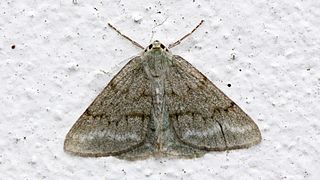
Idaea, sometimes called Hyriogona, is a large genus of geometer moths. It was erected by Georg Friedrich Treitschke in 1825. They are found nearly worldwide, with many native to the Mediterranean, the African savannas, and the deserts of western Asia.

Aeolochroma is a genus of moths in the family Geometridae described by Prout in 1912.

Bosara is a genus of moths in the family Geometridae.

Chloroclystis is a genus of moths in the family Geometridae first described by Jacob Hübner in 1825.

Cyclophora is a genus of moths in the family Geometridae. Many species are referred to as mochas in reference to their colouration, primarily in Europe.

Hemithea is a genus of moths in the family Geometridae erected by Philogène Auguste Joseph Duponchel in 1829. In 1999 there were about 31 species in the genus.

Pingasa is a genus of moths in the family Geometridae first described by Frederic Moore in 1887.

Scopula is a genus of moths in the family Geometridae described by Franz von Paula Schrank in 1802.

Oenochrominae is a subfamily of the moth family Geometridae.

Asthenini is a tribe of geometer moths under subfamily Larentiinae first described by Warren in 1893. The tribe has been combined with Eupitheciini in the past, most notably by Jeremy Daniel Holloway in his work The Moths of Borneo.

Melanthiini is a tribe of geometer moths under subfamily Larentiinae. The tribe was described by Philogène Auguste Joseph Duponchel in 1845.

The Pseudoterpnini are a tribe of geometer moths in the subfamily Geometrinae. The tribe was described by Warren in 1893. It was alternatively treated as subtribe Pseudoterpniti by Jeremy Daniel Holloway in 1996.
Eupithecia mitigata is a moth in the family Geometridae. It is found in Afghanistan, Tajikistan, Kyrgyzstan, southern Kazakhstan, north-western China (Xinjiang) and Kashmir.
Bosara maior is a moth in the family Geometridae that is endemic to Sri Lanka.
Bosara torquibursa is a moth in the family Geometridae which is endemic to Papua New Guinea.
Bosara maculilinea is a moth in the family Geometridae. It is found in Papua New Guinea.

Cosymbiini is a tribe of the geometer moth family (Geometridae), with about 515 species in 11 genera, and 5 genera with 170 species tentatively associated with the tribe.













